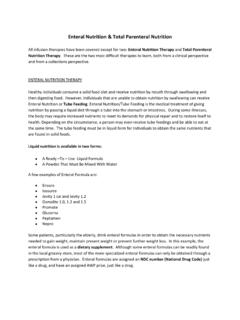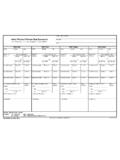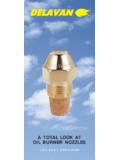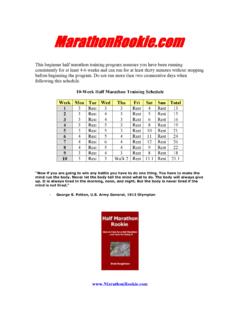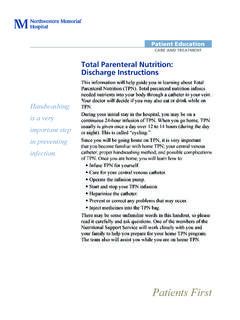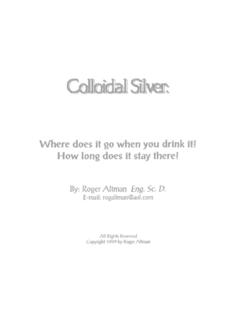Transcription of THE HEATH-CARTER ANTHROPOMETRIC …
1 THE HEATH-CARTER ANTHROPOMETRIC somatotype - INSTRUCTION manual - carter , Department of Exercise and Nutritional Sciences San Diego State University San Diego, CA. 92182-7251. Email: The figures in this manual may be reproduced for class use without specific permission. Revised by carter San Diego, CA. This revision is adapted from the original instruction manual by the author and a later version published in a CD-Rom titled Anthropometry Illustrated (Ross, Carr & carter , 1999), in association with TeP and ROSSCRAFT, Surrey, Canada. March 2002 somatotype Instruction manual 2 3/19/2003 Part 1: The HEATH-CARTER ANTHROPOMETRIC somatotype - Instruction manual - carter , Department of Exercise and Nutritional Sciences San Diego State University San Diego, CA.
2 92182-7251. Introduction The technique of somatotyping is used to appraise body shape and composition. The somatotype is defined as the quantification of the present shape and composition of the human body. It is expressed in a three-number rating representing endomorphy, mesomorphy and ectomorphy components respectively, always in the same order. Endomorphy is the relative fatness, mesomorphy is the relative musculo-skeletal robustness, and ectomorphy is the relative linearity or slenderness of a physique. For example, a 3-5-2 rating is recorded in this manner and is read as three, five, two. These numbers give the magnitude of each of the three components.
3 Ratings on each component of to 2 are considered low, 3 to 5 are moderate, 5 to 7 are high, and 7 and above are very high ( carter & heath , 1990). The rating is phenotypical, based on the concept of geometrical size-dissociation and applicable to both genders from childhood to old age. The HEATH-CARTER method of somatotyping is the most commonly used today. There are three ways of obtaining the somatotype . (1) The ANTHROPOMETRIC method, in which anthropometry is used to estimate the criterion somatotype . (2) The photoscopic method, in which ratings are made from a standardized photograph. (3) The ANTHROPOMETRIC plus photoscopic method, which combines anthropometry and ratings from a photograph - it is the criterion method.
4 Because most people do not get the opportunity to become criterion raters using photographs, the ANTHROPOMETRIC method has proven to be the most useful for a wide variety of applications. Purpose The purpose of this chapter is to provide a simple description of the ANTHROPOMETRIC somatotype method. It is intended for those who are interested in learning "how to do it". To obtain a fuller understanding of somatotyping, its uses and limitations, the reader should consult "Somatotyping - Development and Applications", by carter and heath (1990). The ANTHROPOMETRIC somatotype Method Equipment for anthropometry ANTHROPOMETRIC equipment includes a stadiometer or height scale and headboard, weighing scale, small sliding caliper, a flexible steel or fiberglass tape measure, and a skinfold caliper.
5 The small sliding caliper is a modification of a standard ANTHROPOMETRIC caliper or engineer s vernier type caliper. For accurate measuring of biepicondylar breadths the caliper branches must extend to 10 cm and the tips should be cm in diameter ( carter , 1980). Skinfold calipers should have upscale interjaw somatotype Instruction manual 3 pressures of 10 gm/mm2 over the full range of openings. The Harpenden and Holtain calipers are highly recommended. The Slim Guide caliper produces almost identical results and is less expensive. Lange and Lafayette calipers also may be used but tend to produce higher readings than the other calipers (Schmidt & carter , 1990).
6 Recommended equipment may be purchased as a kit (TOM Kit) from Rosscraft, Surrey, Canada (email: or ). Measurement techniques Ten ANTHROPOMETRIC dimensions are needed to calculate the ANTHROPOMETRIC somatotype : stretch stature, body mass, four skinfolds (triceps, subscapular, supraspinale, medial calf), two bone breadths (biepicondylar humerus and femur), and two limb girths (arm flexed and tensed, calf). The following descriptions are adapted from carter and heath (1990). Further details are given in Ross and Marfell-Jones (1991), carter (1996), Ross, Carr and carter (1999), Duquet and carter (2001) and the ISAK manual (2001).
7 Stature (height). Taken against a height scale or stadiometer. Take height with the subject standing straight, against an upright wall or stadiometer, touching the wall with heels, buttocks and back. Orient the head in the Frankfort plane (the upper border of the ear opening and the lower border of the eye socket on a horizontal line), and the heels together. Instruct the subject to stretch upward and to take and hold a full breath. Lower the headboard until it firmly touches the vertex. Body mass (weight). The subject, wearing minimal clothing, stands in the center of the scale platform. Record weight to the nearest tenth of a kilogram.
8 A correction is made for clothing so that nude weight is used in subsequent calculations. Skinfolds. Raise a fold of skin and subcutaneous tissue firmly between thumb and forefinger of the left hand and away from the underlying muscle at the marked site. Apply the edge of the plates on the caliper branches 1 cm below the fingers of the left hand and allow them to exert their full pressure before reading at 2 sec the thickness of the fold. Take all skinfolds on the right side of the body. The subject stands relaxed, except for the calf skinfold, which is taken with the subject seated. Triceps skinfold.
9 With the subject's arm hanging loosely in the anatomical position, raise a fold at the back of the arm at a level halfway on a line connecting the acromion and the olecranon processes. Subscapular skinfold. Raise the subscapular skinfold on a line from the inferior angle of the scapula in a direction that is obliquely downwards and laterally at 45 degrees. Supraspinale skinfold. Raise the fold 5-7 cm (depending on the size of the subject) above the anterior superior iliac spine on a line to the anterior axillary border and on a diagonal line going downwards and medially at 45 degrees. (This skinfold was formerly called suprailiac, or anterior suprailiac.)
10 The name has been changed to distinguish it from other skinfolds called "suprailiac", but taken at different locations.) Medial calf skinfold. Raise a vertical skinfold on the medial side of the leg, at the level of the maximum girth of the calf. Biepicondylar breadth of the humerus, right. The width between the medial and lateral epicondyles of the humerus, with the shoulder and elbow flexed to 90 degrees. Apply the caliper at an angle approximately bisecting the angle of the elbow. Place firm pressure on the crossbars in order to compress the subcutaneous tissue. Biepicondylar breadth of the femur, right.

